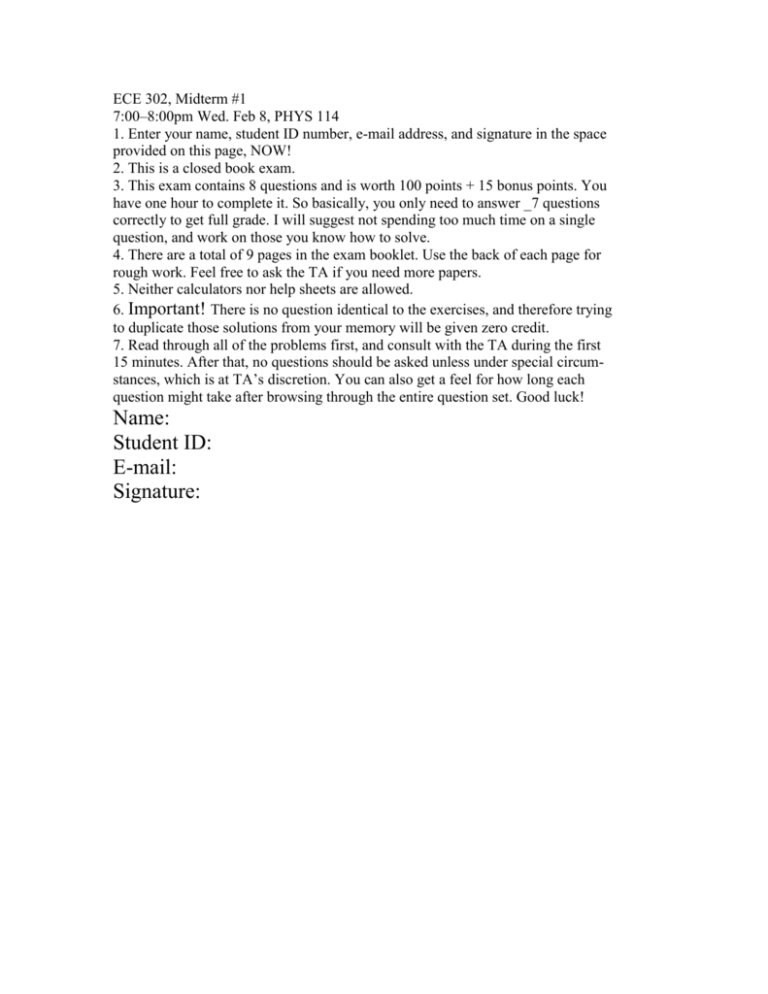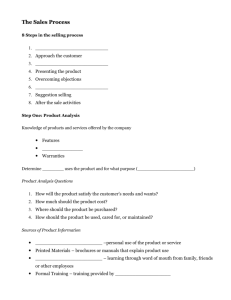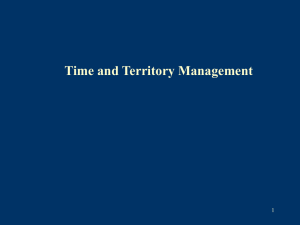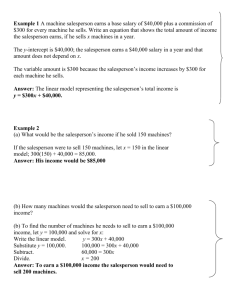Probability and Stochastic
advertisement

ECE 302, Midterm #1
7:00–8:00pm Wed. Feb 8, PHYS 114
1. Enter your name, student ID number, e-mail address, and signature in the space
provided on this page, NOW!
2. This is a closed book exam.
3. This exam contains 8 questions and is worth 100 points + 15 bonus points. You
have one hour to complete it. So basically, you only need to answer _7 questions
correctly to get full grade. I will suggest not spending too much time on a single
question, and work on those you know how to solve.
4. There are a total of 9 pages in the exam booklet. Use the back of each page for
rough work. Feel free to ask the TA if you need more papers.
5. Neither calculators nor help sheets are allowed.
6. Important! There is no question identical to the exercises, and therefore trying
to duplicate those solutions from your memory will be given zero credit.
7. Read through all of the problems first, and consult with the TA during the first
15 minutes. After that, no questions should be asked unless under special circumstances, which is at TA’s discretion. You can also get a feel for how long each
question might take after browsing through the entire question set. Good luck!
Name:
Student ID:
E-mail:
Signature:
Question 4: (12%) Two numbers X and Y are independently selected from the interval
[0,1] uniformly randomly.
1. (5%) Find the probability that they differ by more than 1/3.
2. (7%) The two events A and B are defined as follows:
A = {X > 0.5},
B = {X > Y }.
Show that A and B are NOT independent.
Question 5: (17%) A normal six-faced fair die is tossed and the number of dots N1 is
noted; an integer N2 is then selected from {N1, …, 6} uniformly randomly.
1. (2%) Specify the sample space.
2. (5%) Use either a tree diagram or a table method to construct the weight
assignments (the probabilities).
3. (5%) Find the probability of the event {N1 + N2 >= 10}.
4. (5%) Find the probability of the event {N1 = 4} given {N2 = 6}.
Question 6: (15%) A salesperson travelled between cities A, B, and C for four
consecutive nights, and each night he could only stay in one city. At day 1, the
salesperson started from city A and stayed there for the first night. For the next three
mornings, the salesperson uniformly randomly selected the next destination from the two
cities excluding the city he stayed for the last night. For example, if he stayed in city B
for the third night, the fourth night of his can only be in either city A or city C.
1. (8%) What is the probability that the salesperson was able to visit all three
cities?
2. (7%) What is the probability that the salesperson visited city A twice, given that
the salesperson had visited all three cities.
Question 7: (24%) The waiting time X of a customer in a queueing system is zero if he
finds the system idle, and an exponentially distributed random length of time if he finds
the system busy. The probabilities that he finds the system busy or idle are q and 1 − q,
respectively.
1. (2%) What is the sample space? Hint, the waiting time t takes values in real
numbers.
2. (7%) What is the corresponding cumulative distribution function (cdf)? Hint:
consider two cases: x < 0 and x >= 0.
3. (3%) Using the cdf obtained in 2., compute the probability P(X ∈ [0, 3])?
4. (2%)What kind of random variables is X? A discrete random variable, a
continuous random variable, or a mixed random variable? It is a multiple-choice
question. No need to write down the justification.
5. (10%) Construct the generalized probability density function (pdf) using delta
functions, namely, using δ(x − x0).
For your reference, the pdf of an exponential distribution is f(t) = λe−λt, where λ >= 0
is a parameter.
Question 8: (15%) Suppose X is a random variable uniformly distributed on [−1, 1], and
x2
Y is defined by Y = 2 + 1.
1. (8%) Find the cumulative distribution function FY (y) = P(Y <= y). Hint:
consider two cases: y < 1 and y >= 1.
2. (7%) Find the probability density function fY (y).
Question 8: (15%)
Probability and Stochastic
Midterm 1
Question 1:(12%) Compute the values of the following integrals.
10
1. (3%) ∫−10 ye−3|y| dy
10
y2
2. (3%) ∫−10 ye
3. (3%)
− 2
2x dy
2
(x−μ)
∞
1
−
∫−∞ √2πσ2 e 2σ2
∞
x
4. (3%) ∫−∞ √2πσ2 e
(x−μ)2
−
2σ2
dx
dx
Question 2: (10%)
1. (3%) Using the Venn diagram to prove the DeMorgan’s Rule: For all events
A,B⊆S, (A∪B)c = Ac ∩ Bc.
2. (3%) Using the first result, prove
(A∪B∪C∪D) c = A c ∩ B c ∩ C c ∩ D c .
3. (4%) Throw a fair die four times, and assume each die-tossing is independent.
Compute the probability that a single dot is facing up at least once.
Question 3: (12%) Answer the following questions in sequence.
1. (2%) One person tosses three fair coins. What is the sample space?
2. (2%) What is the weight assignment for this experiment? Let X denote the
number of heads. What is the probabilities of X = 0, 1, 2, 3?
3. (2%) If we treat X as a “random variable,” what is the same space of X?
4. (2%) What is the weight assignment of X that is consistent with the second
sub-question.
5. (2%) Consider another person who also tosses three fair coins independently. Let
Y be the number of heads of his/her outcomes. What is the right sample space
and weight assignment for Y?
6. (2%) What is the sample space when we consider two experiments jointly?
Question 4: (8%) A sequence of bits is transmitted over a channel that introduces errors
(to each bit independently) with bit-by-bit error probability p = 0.01.
1. (2%) What is the pmf of N, the number of error-free bits before the first
erroneous bit?
2. (3%) What is E(N)?
3. (3%) What is the probability P(N ≥ 1000)?
Question 5: (10%) Write down the sample space and weight assignment (pdf) for an
exponential random variable X with parameters λ = 3.
1. (3%) Compute its mean E(X).
2. (3%) Compute its variance Var(X).
3. (4%) What is the probability P(the integer part of X is an even number)?
Question 6: (8%) A random experiment has a sample space S = {x, y, z}. Suppose that
P({x, z}) = 1/3 and P({y, z}) = 8/9. Use the axioms of probability to find the probabilities
of the elementary events, namely, what are P({x}), P({y}), P({z}).
Question 7: (15%) A six-faced die, with faces numbered as 1, · · · , 6, is tossed and the
number of dots facing up is noted.
1. (5%) Show that the event A = {X >= 4} “implies” B = {(X+4) is not a prime
number} “implies” C = {X >= 2}.
2. (5%) Construct the probability of the elementary events under the assumption
that the face with a single dot is three times as likely to be facing up as any one
of the rest 5 faces.
3. (5%) Under the above probability assignment, find the probabilities of P(A),
P(B), P(C).
Question 8: (15%) A salesperson travelled between cities A, B, and C for four
consecutive nights, and each night he could only stay in one city. At day 1, the
salesperson started from city A and stayed there for the first night. For the next three
mornings, the salesperson uniformly randomly selected the next destination from the two
cities excluding the city he stayed for the last night. For example, if he stayed in city B
for the third night, the fourth night of his can only be in either city A or city C.
1. (8%) What is the probability that the salesperson was able to visit all three
cities?
2. (7%) What is the probability that the salesperson visited city A twice, given that
the salesperson had visited all three cities.
Question 9: (10%) Suppose we have two events A and B, and we know P(A) = 0.4, P(B)
= 0.7, and P(A∪B) = 0.9.
1. (6%) Find P(A∩B c). (B c is the compliment of B, namely, B c contains
everything not in B.)
2. (4%) Are A and B independent?
Hint: You may use the Venn diagram and find out the weight assigned to each
region.











